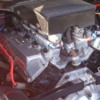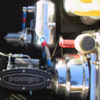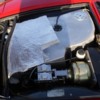quote:
Originally posted by Edge: Plumbing of the vacuum at the manifold are -8 Earl’s fittings.
90 degree at cylinders 4 & 8, both feed forward individually to a tee on top of cylinders 1 & 5, then across the front of the engine & tee into the original supply line. Supply line goes up to the front area, into an Earls check valve, then a vacuum bottle, then into the twin diaphragm booster which has its original check valve.
Understood. It’s big plumbing compared to the 8-line set up in Joe’s post. I’m sure it flows well. One thing that does catch my attention is it appears 1 & 4 are plumbed in series, as are 5 & 8, then I presume the two pairs are plumbed in parallel at 1 & 4 and off to the check valve isolated vacuum plenum. If so, on a 1-3-7-2-6-5-4-8 firing order, it may induce some variation in the average vacuum each cylinder sees at idle because of their different relative positions in the firing order and the communication up and down the -8 line. This can be the case even if the vacuum has stabilized in your check valve isolated plenum (maybe even especially so). Not sure if this could be a contributing factor to the fouling issue but is would seem like it could create some anomalies when you try to vacuum sync the respective cylinders. -I’m sort of paranoid about plumbing symmetry in IR schemes.
quote:
(Ran this twin diaphragm booster when I had the Holly carbie & had heaps of vacuum & great brakes).
Even if it was the same cam, you had the benefit all eight cylinders sucking on the same plenum and butterflies.
quote:
Now the intention is to fit a Hella vacuum pump which also draws on the vacuum bottle.
Fit a switch into the bottle which senses vacuum, switches the pump on at 15 hg & off at 22 hg.
Sounds good.
quote:
Question: Both the vacuum pump & the engine drawing on the vacuum bottle. When the pump is on it will draw close the engine supply check valve? So with this setup, will it ever actually be using engine vacuum?
I would say if you need the pump to begin with, the engine vacuum may likely never get to draw air from your plenum. Sort of depends on the volume of the tank, the level of vacuum the engine can achieve, and displacement of pump and vacuum switch settings. The problem usually is when you need the vacuum most is when you have the least. If you are running WOT, you have no vacuum. If you need the mash on the brakes immediately after WOT, the booster servo needs to catch up. The plenum can at least can store enough for a few actuating cycles but can be drawn down with repeated application of pedal. The pump will likely be capable of higher vacuum than your engine. If you have a big enough reservoir/plenum, you may never draw it down enough to get into the region the engine helps you get there. The higher vacuum from the pump will likely mean crisp actuation of booster. I think you’ll like the pump approach and loose interest in engine vacuum.
What level of vacuum does the plenum stabilize at idle now?
quote:
I am having issues with fouling plugs when idling for extended periods of time. Then the engine starts to mis-fire. This is I think more about getting the butterflies synchronized.
If by misfire that’s backfiring or popping back through the throttle bodies this can be caused by one of the connected cylinders scavenging air from another it is connected to via the vacuum lines, then you have a lean condition which usually is consistent with backfire through carb, especially if you are running a fair amount of ignition advance. It’s a little more unusual for EFI but don’t know if you are running full sequential or different injector scheme.
quote:
Last time I drove it I was fouling plugs, (NGK BCP5E S) on cylinders 5 & 6 which I believe these 2 butterflies must be slightly closed compared to the others, reducing air flow & thus running too rich on those cylinders.
Are you setting the butterflies with feeler gauge then checking with synchrometer type vacuum gauge?
quote:
I need to play with the air-bleed screws more for the idle, instead of relying so much on the idle screw on the butterflies.
The challenge with setting the butterflies to control idle in IR scheme is they can be very position sensitive and a small change in position means a relatively large change in area thus idle speed or air fuel ratio variation cylinder to cylinder. This will be especially true for big throated throttle bodies trying to achieve low idle. It’s easy for the linkage to get out of tune too. I’ve seen lot’s of schemes. Some folks run the butterflies fully closed and drill a hole in each butterfly with diameter near enough to maintain idle and then trim with the idle air screws. On my next scheme, I’m going to try an idle air control valve on a common plenum plumbed to each cylinder and see if I can get decent closed loop response from a wideband O2 sensor.The Roush IR crate motor uses this scheme with reportedly decent success. It also works very well on the more typical plenum/runner/single throttle body set ups, most of which are massflow not speed density schemes.
Take care.
Best,
Kelly









